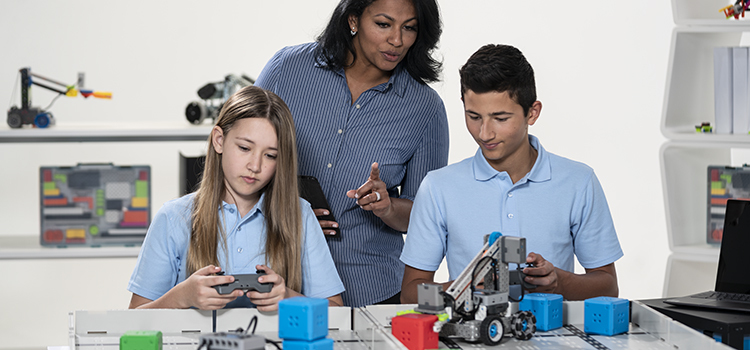This post is sponsored by Vex Robotics
Educators don’t need to read the myriad of news stories on learning slides due to the COVID-19 pandemic and continuing recovery period. Teachers are keenly aware and work hard to engage students and create a learning-positive environment in their classrooms, while balancing the need to make up for those lost instruction hours. The speed and depth of the learning dip alarms K-12 administrators who are seeking creative solutions to reinvigorate their programs. But how can this challenge turn into an opportunity? Incorporating engaging approaches to classroom learning, such as tapping the fun and empowerment of robotics, can answer the how, and why, of learning recovery.
Addressing Unfinished Learning
An uphill climb to recovery could be discouraging to many. Two decades of hard-earned growth seemed to vanish in the past two years, with long-term scores from the National Assessment of Educational Progress bi-annual report showing unprecedented declines in both math and generational literacy for fourth graders, with an even more marked drop for disadvantaged students adding to the already hefty disparity between top-and-lower scorers. However tech leaders and passionate educators are masters at thinking out of the box and finding new paths to success.
A familiar obstacle to many in implementing exciting new programs is a matter of simple subtraction. Hours in the school day minus hours spent on a restrictive curriculum to meet high stakes testing demands equals a negative, in more ways than one. Carving out time to introduce out-of-the-box initiatives– no matter how likely to engage and draw in students– requires creativity and multi-tasking. Fortunately, studies have clearly shown the benefits of interactive high-quality STEM curriculum, particularly in improving critical areas such as mathematical achievement and spatial reasoning.
It is a small step further to see what we as educators and guardians of these young minds intuitively know– improved motivation in itself leads to improved achievement. Results from a study released by the International Journal of STEM Education suggest that spatial skills, in combination with motivation, play a significant role in middle school students’ mathematics achievement.
Robotics Humanizes Learning
Underlying literacy and mathematical thinking show up in skills such as executive function, working memory, motor skills and spatial skills. These foundational components of learning and predictors of school success can be difficult to incorporate into core subjects or embed within traditional instruction, despite being crucial to achievement. Lesson plans involving robotics connect exercising these critical skills to curriculum. Building a robot, or coding a machine to maneuver a path or complete a task can integrate many of these elements into one fun learning session. Even the simplest action such as building from instructions uses spatial reasoning and communication with a partner or group about the pieces, their orientation, quantity, shape, size.and more.
In short, exercise those growing minds not with surface level one-note tasks to make the grade, but stretch the underlying learning muscles to create a strong foundation of long term achievement and motivation. Make learning more human by appealing to a natural love of play and let tech do the heavy lifting to improve student attitudes toward STEM. As we fight the good fight to lift not only low scores, but excitement in the classroom, it makes sense to make the most of these changing times to change learning for the better.
VEX Robotics is the global leader in STEM education, offering the VEX continuum to help students of all abilities find success quickly and also grow their STEM knowledge and competencies. Learn more about how we empower educators to engage and inspire the STEM innovators and problem-solvers of today and tomorrow.
